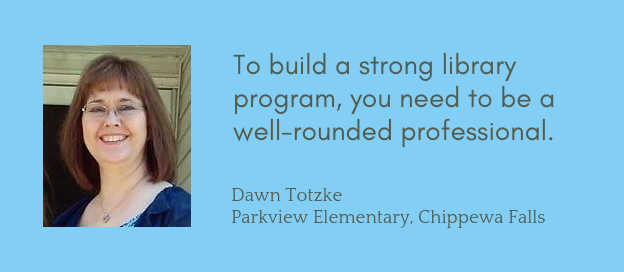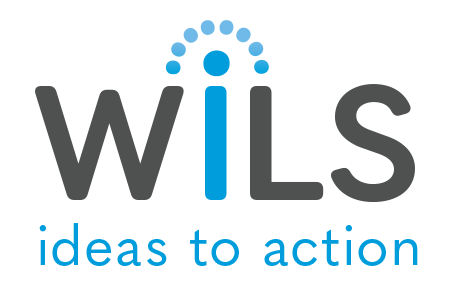
One of our greatest joys at WiLS is hearing our members tell the stories of the big and important work they are doing – interesting new projects or initiatives, or even interesting and new approaches to old projects. And, in addition to hearing about it, it makes us even happier when we can share those stories with other members. Each month, WiLS is proud to feature an interview with one of our library members.
This month, we interview Dawn Totzke, Library Media Specialist at Parkview Elementary in Chippewa Falls, Wisconsin.
Why did you, personally, choose to work in libraries?
A long time ago in the land of Apple 2e’s, I helped my high school librarian create a spreadsheet to track book fines. Well, that should give you a clue to my age! I helped in the library through most of high school, but when I went off to college wanted to be anything besides an educator. It only took about a semester for me to change my mind. I graduated with an elementary education degree with a library minor. After getting my first job in a school library a very smart 4th grader looked at me and said, “I know why you’re a librarian.” He gave me the best answer: “You’re always reading or putting things in order.” Add to that all the wonderful technology that has come along since the Apple 2e and I wouldn’t want to work anywhere else.
What is unique about the culture of your library? How do you influence it?
Each of the three districts that I’ve had the pleasure to work in over the past 24 years has had its own unique culture. The library is a reflection of the building and district, so each one has had its own feel. My current elementary building follows the PBIS (Positive Behavior Interventions and Support) and I find that an easy match for the Library as well. The past year we have used the book “Energy Bus for Kids” as our school-wide theme. Things like that help make connections between the classrooms and the ‘specials’ that students attend. My goal is always to make Library Skills more than just somewhere they go for 40 minutes.
My schedule is also quite unique, I am part of the MAPE (Music, Art, PhyEd) rotation. I see students every 6th school day, which presented issues of responsibility for returning books, but with the teachers on board with weekly reminders home, it has gone well. The schedule also allows me to spend half of each day with scheduled classes and the other half of the day with flexible time. Some of that time is used for standard library management duties, but most of that time is used to interact and collaborate with staff and students. I meet with grade level teachers to help with Professional Development. I work with classrooms on research projects and help with the technology side of things. I also have a chance to work with enrichment groups (while the teachers are working with remedial groups). I’ve worked in things like Code-a-Pillars, Beebots, Ozobots, Cubelets, Dash and Dot, Swift, Scratch, Lego StoryStarters, and Stikbots. The students really enjoy the chance to do these activities and most don’t realize they are working on their problem-solving strategies.
What do you think is important to know about the community you work with? What helps you understand their needs?
To build a strong library program, you need to be a well-rounded professional. I try to keep my self involved in activities that let me see students, staff, parents, and community members outside of the wall of the library. I’m active in our PTO which helps me understand the parent side of things, but also lets me provide them insights about the school day. I attend conferences including SLATE, ISTE, and WEMTA to keep myself informed about the profession and then try to share what I’ve learned with fellow staff. I’m involved in my church giving me another perspective of an organization that actively supports our school. And of course, I take the time to chat with students and parents when I’m out in the community, helping me understand their lives and them to see me as a person and not just a teacher.
What big ideas are being worked on at your library? What problems are being solved?
One of the current big ideas is the development of the ISTE Student Standards within the curriculum, not as my curriculum. Our building is working on making sure all staff members know what the standards are and how the work they do in the classroom is already helping meet those standards. The next step will be to use our additional resources to enhance other lessons to help students become Future Ready.
Students in grades 3-4-5 will each have a Chromebook next year (not taking them home). That changes how teachers will teach and students will be able to show what they know. I’m sure there will be many interesting conversations this spring and summer as we embark on this new adventure. It’s one thing to have technology, it’s another to use it in a way that helps students leverage technology for their benefit.
Our school is entering its second summer of doing a One School, One Read and we are excited about getting a book in everyone’s hands as they leave for vacation. I also send home the Elementary Battle of the Books reading lists with all my students enter 3rd and 4th grade. And the Middle Level list with all my 5th graders as they head off to middle school. We also promote our Public Libraries summer programs with the students during the final weeks of school. Encouraging students to keep reading over the summer can only help them as they come back to us in the fall.
These interviews are part of a series of interviews with both WiLS library and vendor partners. Your feedback is appreciated. If you have any to offer on this article or suggestions for upcoming interviews, contact Andrea Coffin at acoffin@wils.org.
